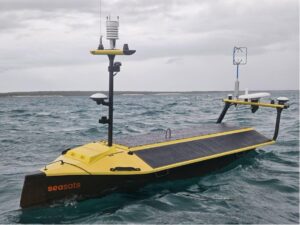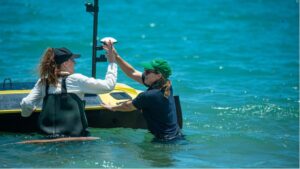SUN Fleet, a fleet of uncrewed surface vehicles, has joined the Global Ocean Observing System to monitor numerous GOOS essential ocean variables and measure important air-sea exchanges in remote areas and under harsh conditions.
SUN Fleet

The Surface UNcrewed Fleet (SUN Fleet) aims to help fill critical monitoring gaps at the ocean surface and in remote and under-observed areas, to help the GOOS ocean observing networks collect data on variables such as ocean temperature, currents, waves, sea level, salinity, nutrients, carbon and oxygen.
The rugged ocean surface robots range in size from 2m to more than 7m and are capable of withstanding hurricane-strength winds. They are equipped to carry instruments that can measure up to 26 essential ocean and climate variables. These variables span physical, biogeochemical, biological and ecological processes, particularly at the air-sea transition zone, and include many surface meteorological variables, making USVs particularly important for marine weather forecasts.
Over the past four years, a global initiative has been underway to coordinate USV observing efforts, develop standards and recommended practices, and support USV manufacturers in entering the scientific market. This work has led to the establishment of the SUN Fleet – a growing international network and collaboration between science and industry that includes contributions from multiple competing USV manufacturers.
The network’s mission is to unite science and industry to build a profitable, scalable and sustainable global USV market, which will deliver FAIR (findable, accessible, interoperable, reusable) and fit-for-purpose ocean observations.
The initiative has been spearheaded by Northern Australian USV specialist Ruth Patterson and NOAA’s Pacific Marine Environmental Laboratory expert in air-sea interactions, Meghan Cronin, alongside 51 other industry, academic and government USV specialists from 40 institutions across nine countries to build the vision for an international ocean observing network.
“The true value of these USVs for improving forecasts will come when their data from coastal regions to the remotest regions of the global ocean can be fed into operational models within minutes of being captured,” said Cronin.
Patterson added, “SUN Fleet will coordinate a global effort with outcomes greater than the sum of the individual parts. Individual USV manufacturers and their investors require a global network of scientists to help them develop their quality-assured data products. SUN Fleet will allow us to transcend traditional siloed approaches to data delivery, and this will benefit industry and humankind.”

An emerging GOOS network
In April 2025, the SUN Fleet was endorsed by the GOOS Observations Coordination Group under UNESCO-IOC as an emerging ocean observing network. This designation recognizes that SUN Fleet is organizing at the global level to meet the attributes of an operational global ocean observing network.
“The GOOS Observations Coordination Group helps networks reach maturity to deliver observations that are interoperable, accessible and fit for purpose,” said David Legler, co-chair of the GOOS Steering Committee. “We are very pleased to recognize the amazing progress of the SUN Fleet autonomous observing system.
“The SUN Fleet brings an exciting new dimension to our global observing capabilities. Their ability to collect high-resolution data in hard-to-reach areas and during extreme conditions, such as in hurricanes, helps close critical gaps in our understanding of ocean-atmosphere interactions, which will ultimately lead to better forecasts. For GOOS, the addition of this emerging network signals both innovation and greater integration – exactly what we need to build a truly responsive, global ocean observing system.”
In related news, Indonesia’s Meteorology, Climatology and Geophysics Agency (BMKG) recently signed a €93m (US$106m) agreement with investment firm CNP and Earth observation and environmental monitoring services provider Collecte Localisation Satellites (CLS), a subsidiary of the French space agency (CNES). Read the full story here



